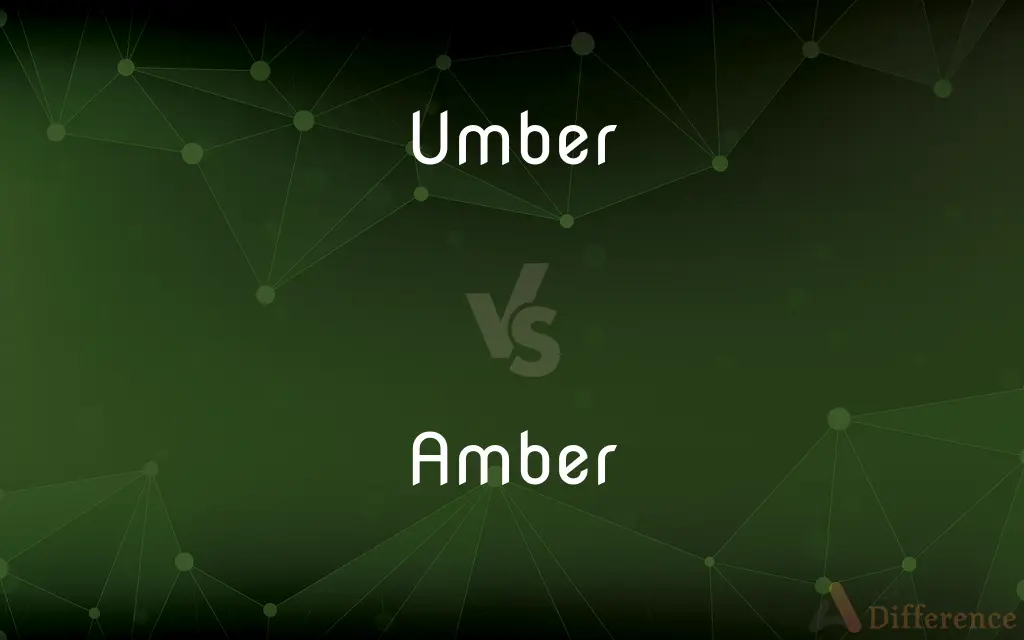Umber vs. Amber — What's the Difference?
By Tayyaba Rehman & Fiza Rafique — Updated on March 1, 2024
Umber is a natural brown or reddish-brown earth pigment containing iron oxide and manganese oxide, used in art and painting. Amber is a fossilized tree resin, typically yellow to orange in color, prized in jewelry and as an ingredient in perfumes.

Difference Between Umber and Amber
Table of Contents
ADVERTISEMENT
Key Differences
Umber and amber, despite their phonetic similarity, belong to entirely different categories of natural materials with distinct uses and origins. Amber, on the other hand, is organic and originates from the fossilized resin of ancient trees. Over millions of years, this resin hardens and transforms into the gemstone known for its warm luster and the ability to preserve ancient organisms as inclusions. Amber's color palette ranges from pale yellow to a deep, rich orange or even green and blue in rare cases. It holds significant value in jewelry making for its beauty and in perfumery for its unique scent.
Umber is an earth pigment, found in various shades of brown and utilized primarily in the art world for its rich, natural tones. This pigment is mined from the earth, where it forms naturally over millions of years through the oxidation of iron and manganese. It's a favorite among painters for adding depth and warmth to their works, especially in oil painting and as a base color in underpainting techniques. Additionally, amber has been attributed with various cultural and historical significances, often believed to possess healing properties and used in folk medicine.
The primary distinction between umber and amber lies in their composition and application, umber is an inorganic pigment used for coloration in art, while amber is an organic gemstone valued for its aesthetic and historical properties. Umber's value is in its utility to artists as a pigment, whereas amber's value is tied to its beauty, rarity, and the unique snapshots of prehistoric life it may encapsulate.
The geographical sources of umber and amber also differ. Umber is mined in various parts of the world, with significant sources including Cyprus and Italy, where the natural conditions favor the formation of this pigment. Amber is primarily found in the Baltic region, which is renowned for its amber deposits, along with other notable locations like the Dominican Republic and Myanmar, each producing amber with distinctive characteristics.
Umber and amber may sound similar, they are distinguished by their nature, origin, and use umber as a pigment in artistry and amber as a treasured organic gemstone in jewelry and perfumery.
ADVERTISEMENT
Comparison Chart
Nature
Inorganic earth pigment.
Organic fossilized tree resin.
Color
Brown or reddish-brown.
Ranges from yellow to orange, sometimes green or blue.
Origin
Formed from iron and manganese oxidation.
Formed from the fossilization of tree resin.
Use
Used as a pigment in painting and art.
Used in jewelry, perfumery, and for its historical significance.
Composition
Contains iron oxide and manganese oxide.
Composed of carbon, hydrogen, oxygen, and sometimes sulfur.
Value
Valued for its coloration properties in art.
Valued for its beauty, rarity, and historical properties.
Geographic Source
Found in Cyprus, Italy, and other regions.
Primarily found in the Baltic region, Dominican Republic, and Myanmar.
Compare with Definitions
Umber
A brown earth pigment used in art.
The artist chose umber for the painting's shadows to add depth.
Amber
Sourced from the Baltic region.
Baltic amber is renowned for its quality and historical value.
Umber
Mined from the earth.
The best quality umber is mined in Cyprus.
Amber
Ranges in color from yellow to orange.
The amber's deep orange hue caught the light beautifully.
Umber
Adds warmth to artworks.
Adding umber to the palette warms up the entire composition.
Amber
Contains ancient inclusions.
This amber piece contains a perfectly preserved ancient insect.
Umber
Contains iron and manganese oxides.
Umber's rich color comes from its iron and manganese content.
Amber
Used in perfumery for its scent.
The perfume's unique aroma was derived from amber resin.
Umber
Popular in oil painting.
Umber is favored for underpainting techniques in oil portraits.
Amber
Fossilized tree resin used in jewelry.
The necklace featured a stunning piece of amber.
Umber
Umber is a natural brown or reddish-brown earth pigment that contains iron oxide and manganese oxide. Umber is darker than the other similar earth pigments, ochre and sienna.In its natural form, it is called raw umber.
Amber
Amber is fossilized tree resin that has been appreciated for its color and natural beauty since Neolithic times. Much valued from antiquity to the present as a gemstone, amber is made into a variety of decorative objects.
Umber
A natural brown earth containing ferric oxide and manganese oxides, used as pigment.
Amber
Hard translucent fossilized resin originating from extinct coniferous trees of the Tertiary period, typically yellowish in colour. It has been used in jewellery since antiquity.
Umber
Any of the shades of brown produced by umber in its various states.
Amber
A hard, translucent, usually brownish-yellow fossil resin, used for making jewelry and other ornamental objects.
Umber
Of or related to umber.
Amber
To preserve in amber; as, an ambered fly.
Umber
Having a brownish color.
Amber
A deep yellow color;
An amber light illuminated the room
He admired the gold of her hair
Umber
To darken with or as if with umber.
Amber
A hard yellowish to brownish translucent fossil resin; used for jewelry
Umber
Of or pertaining to umber; resembling umber; olive-brown; dark brown; dark; dusky.
Their harps are of the umber shadeThat hides the blush of waking day.
Amber
A medium to dark brownish yellow color
Umber
To color with umber; to shade or darken; as, to umber over one's face.
Umber
An earth pigment
Umber
A medium to dark brown color
Umber
Of the color of any of various natural brown earth pigments
Common Curiosities
What is amber?
Amber is fossilized tree resin, often used in jewelry and perfumery, known for its warm colors and the ability to preserve ancient life forms.
How is umber used in art?
Umber is used for its deep, natural tones, especially in creating shadows, depth, and warmth in oil paintings and underpaintings.
What makes Baltic amber special?
Baltic amber is renowned for its quality, high concentration of succinic acid, which is believed to have therapeutic properties, and its historical significance.
Why is amber valued in jewelry?
Amber is prized for its beauty, rarity, and the unique, often prehistoric, inclusions it contains, making it a fascinating and desirable gemstone.
Can umber only be found in certain locations?
Yes, umber is mined in specific regions where the natural conditions allow for the formation of its unique pigment, such as Cyprus and Italy.
Is all amber yellow?
No, while yellow to orange is common, amber can also be found in green, blue, and even red hues, depending on its origin and conditions of fossilization.
What is the significance of inclusions in amber?
Inclusions in amber, such as insects or plant material, provide invaluable scientific insights into ancient ecosystems and life forms.
Is there synthetic umber?
Yes, synthetic versions exist, but natural umber is preferred for its unique qualities in art.
What is umber?
Umber is a natural earth pigment, characterized by its brown or reddish-brown color, used in painting and art for its rich tones.
How old is amber?
Amber can range from 20 to 300 million years old, depending on the deposit it comes from.
Are there different types of umber?
Yes, there are variations like raw umber (natural state) and burnt umber (heated to intensify color), each offering different tones and warmth.
How is amber used in perfumery?
Amber resin is processed to extract an oil used for its warm, earthy scent in perfumes, adding depth and richness.
Do artists prefer a specific type of umber?
Artists may choose between raw and burnt umber based on the desired temperature and depth of color in their work.
Can umber affect the longevity of a painting?
Umber is stable and lightfast, making it a durable pigment that does not significantly alter the longevity of a painting.
What are the therapeutic claims associated with amber?
Amber, especially Baltic amber, is believed to have anti-inflammatory and analgesic properties, often used in amber teething necklaces and alternative therapies.
Share Your Discovery

Previous Comparison
Evolve vs. Ascend
Next Comparison
Art vs. DisciplineAuthor Spotlight
Written by
Tayyaba RehmanTayyaba Rehman is a distinguished writer, currently serving as a primary contributor to askdifference.com. As a researcher in semantics and etymology, Tayyaba's passion for the complexity of languages and their distinctions has found a perfect home on the platform. Tayyaba delves into the intricacies of language, distinguishing between commonly confused words and phrases, thereby providing clarity for readers worldwide.
Co-written by
Fiza RafiqueFiza Rafique is a skilled content writer at AskDifference.com, where she meticulously refines and enhances written pieces. Drawing from her vast editorial expertise, Fiza ensures clarity, accuracy, and precision in every article. Passionate about language, she continually seeks to elevate the quality of content for readers worldwide.














































